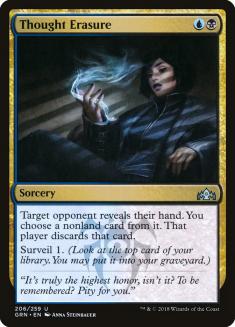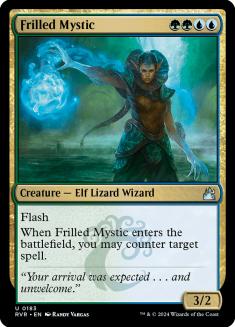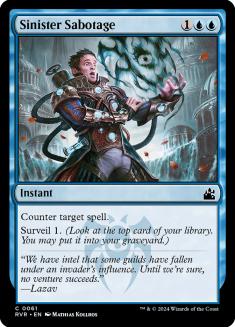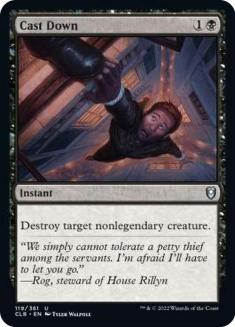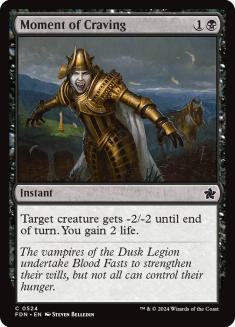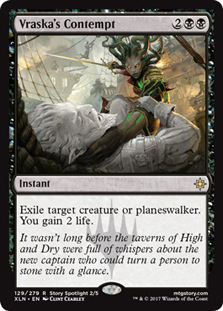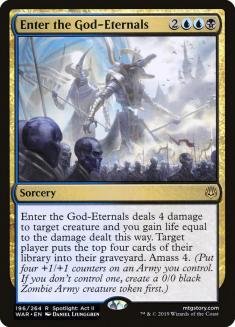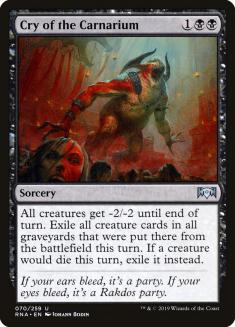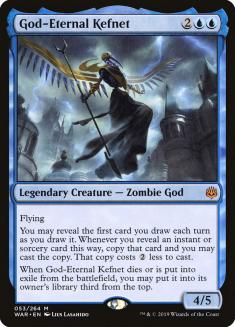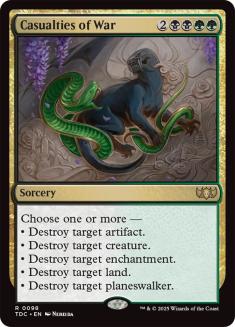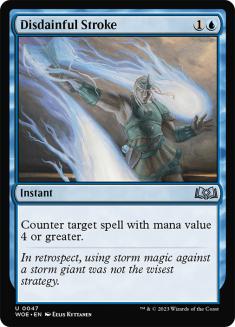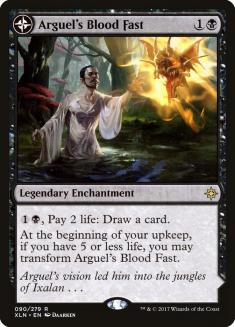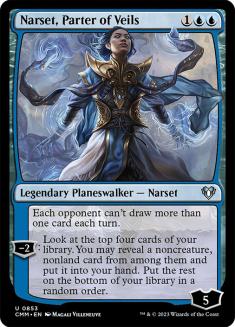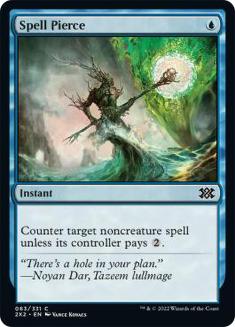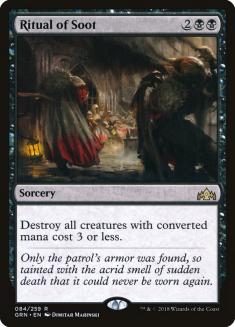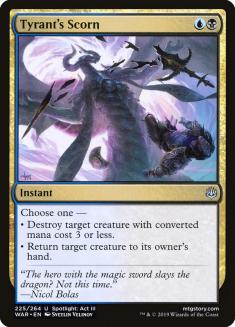Tamiyo, Collector of Tales was quickly identified as a great addition to Simic Nexus, as the +1 ability helps shrink your deck so that it becomes easier to find your Nexus of Fates, and the -3 can pick up whatever you need, often a Root Snare. However, I believe Tamiyo is a well-rounded planeswalker whose utility is not limited to Simic Nexus and I’ve been doing work to find an ideal Tamiyo midrange/control deck.
It clicked for me when I compared Tamiyo to Eternal Witness. For one more mana, instead of a 2/1, you get a two-loyalty planeswalker, but also, if you don’t have a stocked graveyard, you can immediately use the +1 instead of the -3 to fill your graveyard and queue up an extra Regrowth.
I loved Eternal Witness in Standard, and one of my all-time favorite Standard decks was this spicy number that Mike Hron built for States in 2005:
Creatures (17)
- 4 Sakura-Tribe Elder
- 4 Birds of Paradise
- 4 Eternal Witness
- 1 Bringer of the Blue Dawn
- 1 Bringer of the Black Dawn
- 1 Pristine Angel
- 1 Viridian Shaman
- 1 Molder Slug
Lands (21)
Spells (22)

This deck used Eternal Witness to tutor from a graveyard that it stocked up with Gifts Ungiven, but Tamiyo does both halves of that by itself, and also happens to lead to some fantastic recursive loops that cards which return multiple cards usually prevent by including an exile clause (which was conveniently left off Planewide Celebration).
This deck’s basic strategy of using Eternal Witness with interactive spells and a toolbox of powerful late-game bombs is what I was looking to capture with Tamiyo in this Standard format.
As I’ve discussed recently, Standard has enough incidental self-milling that Tamiyo’s -3 is among the most powerful of any planeswalker abilities (other than ultimates) in Standard. In the deck I’ve been playing, it often feels like “-3: Do whatever you want.”
My favorite interaction with Tamiyo has been the combination of Tamiyo with Planewide Celebration. Since both cards can return the other while generating additional value, this combination offers a remarkably dominant end-game if your opponent doesn’t have counterspells or the ability to exile all of your Tamiyos. The deck I’ve played to survive to this point is the following:
Creatures (12)
Planeswalkers (3)
Lands (26)
Spells (19)

Let’s go through the card-by-card breakdown, starting at the top of the curve and working down.
The Maindeck
This card shouldn’t need any explanation in this kind of deck. This is really a Hydroid Krasis deck, and it’s the best thing to name with Tamiyo when you just generically want more value, so it wouldn’t make sense to play fewer than four.
I’m only playing one copy because you never want to draw a seven-mana spell early and drawing multiples can easily cost you a game where you need to interact early, and also the single copy does everything you need. This card loops with Tamiyo in multiple ways, in that you can either return a Tamiyo from your graveyard or, if Tamiyo is still on the battlefield, you can proliferate it up to use the -1 again.
For example, you could cast Tamiyo and return Planewide Celebration to your hand, leaving you with a two-loyalty Tamiyo. Then, if they don’t kill Tamiyo, the next turn you can cast Planewide Celebration to proliferate twice (increasing the size of any Jadelight Ranger, Hydroid Krasis, or Zombie Army you happened to control) to get Tamiyo up to four loyalty; choose any two other modes of Planewide Celebration; and then immediately use Tamiyo’s -3 again to get Planewide Celebration back and keep a one-loyalty Tamiyo. Or, if you want, you could only proliferate once so that your Tamiyo goes to the graveyard so that you can return it. Which of those is better largely depends on whether you want Tamiyo on the battlefield to stop your opponent from disrupting your combo with discard thanks to Tamiyo’s static ability.
Even without Tamiyo, this card just does so much. I’ve cast it to return a Jadelight Ranger and three Frilled Mystics to my hand, and I’ve cast it to gain twelve life and return a Hydroid Krasis against red.
There are a lot of great things Sultai can do with six mana, but I believe this is the best of them to pair with Tamiyo because it gets you out of the most spots, and looping a removal spell that destroys your opponent’s land leaves them unable to get back into the game with a topdecked Hydroid Krasis or something. This also helps keep Spell Pierce live in the late-game.
Ordinarily, I like diversity in my six drops, so I might play one Casualties of War; one Liliana, Dreadhorde General; and one Ugin, the Ineffable or something, and Tamiyo’s -3 ability rewards diversity so that it has more optionality. That said, Tamiyo’s +1 ability strongly encourages playing three or four copies of cards you might want to look for with it, and I think Tamiyo’s -3 naturally has all the optionality it needs in this deck. The only reason I’d change this is if I felt like I needed Liliana in order to answer Carnage Tyrant, but I currently believe that the fact that Liliana exists is doing enough to keep Carnage Tyrant out of people’s decks that it isn’t a concern.
The curve in this deck is fairly high and the aggro decks in this format are very strong. This card is necessary to have enough power to catch up from their early-game. Also, milling yourself for four when you cast it is awesome, because it loads up your graveyard for Planewide Celebration and Tamiyo.
After playing against Grixis it became clear that the games followed a pattern. They would try to use discard to push a hole through my defenses to untap with either Thief of Sanity or Nicol Bolas, Dragon-God, and if they did either, I basically lost on the spot, yet if I could keep their threats off the battlefield, the fact that they couldn’t really prevent my sources of card advantage meant I was a huge favorite in the late-game.
Kefnet gives me access to a threat that leads to free wins where I run away with the game if I untap with it, rather than just grinding forever like the rest of my cards. The fifth toughness is great in the format, spiking any of my expensive spells off it is insane, and it also plays really well with Tamiyo, since if they kill it, I put it on top, and then I can name it with Tamiyo’s +1 to guarantee a hit.
It’s good to have access to a way to exile things and a hedge against cheap planeswalkers that you can’t wait to answer with Casualties of War, and Vraska’s Contempt has always just been a strong, versatile card. The fact that Nexus has added Tamiyo helps, as that was a matchup where it was historically dead, and now it does something.
I want access to some ability to counter spells, since I’m playing such long games, and this pressures planeswalkers and can be returned with Tyrant’s Scorn or Planewide Celebration, unlike other counterspells.
Surveilling is great in this deck and I think I want another three-mana spell on top of Jadelight Ranger, so I’m splitting my counterspells between Frilled Mystic and this.
This card is absolutely essential and I wish I could play more of them. (I’m aware of Merfolk Branchwalker, but I think it’s too low impact/not good enough at finding lands; still, in the right format it might make sense to play it over Thought Erasure.) It helps stabilize the battlefiled early and makes sure I keep making my land drops, as this deck really wants to play a land every turn of the game. It’s really nice to be able to name it with Tamiyo when I need to find more lands, and it’s a great way to load up the graveyard.
4 Tyrant’s Scorn
This card has exceeded my very high expectations. Yes, Cast Down can kill more expensive creatures, but many of them are legends that Cast Down can’t kill anyway, like God-Eternals, and Tyrant’s Scorn is almost always better than Cast Down against Rekindling Phoenix. The fact that this can return your own creatures also makes it far from dead against Esper Control, something that can’t be said about many removal spells. This card is absolutely essential to the deck.
If the metagame were almost all aggro decks, I could see moving this to the sideboard, but I think there are too many combo and control decks and access to this is too important. Surveil 1 is also fantastic here, of course, since this deck uses the graveyard and selection so well.
Search for Azcanta is fantastic in this deck, but this deck is also already so good at spending mana in the late-game that you don’t really need it, so I don’t think it’s worth playing more than a single copy. It might even be right to cut this one, but it’s so good against Grixis that I’m hesitant to.
This looks really random. I had two but cut one when I made room for Kefnet, but I wouldn’t mind finding room for another again. With so many planeswalkers in the format, it plays well against almost everyone, and countering a play for a single mana is almost always a huge blowout. As I mentioned earlier, Casualties of War keeping it live longer is a nice bonus.
Sideboarding
The sideboard is designed to let me lower my curve against aggro decks or take out my removal against control decks. Most of the cards are the basic cards you’d expect to want to bring in against the decks where I’m expecting to bring them in. I was playing Davriel, Rogue Shadowmage over Narset, Parter of Veils, but then I cast Davriel and my Esper opponent cast Narset and I lost badly, and I think that Narset’s ability to find discard spells allows it to do a good enough Davriel impression while having a much more relevant static ability, so I believe it’s just a better card here, even if I only expect to hit with the -2 around 80% of the time (note that I have no creatures in the sideboard, so that’s the floor, and it goes up if you sideboard out any creatures).
So how does this deck match up and sideboard against the decks that proved themselves at SCG Richmond?
Mono-Red Aggro
Mono-Red Aggro was not only the winner, it took the top three slots, making it the clear Week 1 deck to beat. As configured, I’m behind against them in Game 1, but I believe I make up for it in sideboarding.
Out:
In:
Red decks often slow down after sideboarding so that they don’t fold to an Enter the God-Eternals, and they bring in cards like Treasure Map; Chandra, Fire Artisan; or Experimental Frenzy, all of which make Casualties of War much better, so I don’t sideboard it out even though it’s usually bad against their maindeck. I believe this post-sideboard configuration has enough cheap removal to slow them down and a great gamebreaking top-end, enough so that I feel heavily favored after sideboarding.
Esper Control
Esper Control took the next top spot at fourth and was one of two other archetypes to put multiple pilots in the Top 8. I like my matchup against them because it’s easier for me to interact with their card advantage than it is from them to interact with mine.
Out:
In:
I’d like to be able to cut Tyrant’s Scorn instead of Vraska’s Contempt and Casualties of War, but I think the matchup is good enough that you just want to hedge against Thief of Sanity, and they’ll have to use removal on your creatures, and you get value when you return any of them to your hand (Jadelight Ranger, Hydroid Krasis, and Frilled Mystic are the only creatures you’ll have in your deck at this point).
Bant Midrange
While this deck did well at SCG Richmond, it hasn’t been especially popular on Arena from what I’ve seen, or at least, I haven’t happened to play against it. I know that Bant value decks can sometimes give control decks problems by getting ahead and having counters at the right time, and I could see this matchup going either way. If it’s a problem, I’d look to address it by adding Hostage Taker to the sideboard. As is, I’d try sideboarding like this.
Out:
In:
I’m not sure that this is optimal, but my instinct is that they play a better flash game and you don’t want to try to hold up mana against them, and you can’t afford to play narrow cards like Duress. I think you want to just keep playing powerful answers and hope to wear down their limited interaction.
Simic Nexus
Your basic plan here is to disrupt them long enough that you can cast Casualties of War, and catching both an enchantment and a land with that sets them back a long way while you attack with whatever you have. They don’t have Thief of Sanity, so you’re free to cut Tyrant’s Scorn.
Out:
In:
Grixis Control
Grixis didn’t make the Top 8 of the Open, but it did win the Standard Classic in Richmond. I discussed this matchup briefly earlier, but basically they have a window of around Turns 3-7 to stick a dominant planeswalker or Thief of Sanity if they’re playing it, and if they don’t do that, you probably just out-resource them and run away with the late-game.
Out:
In:
I’m not totally sure about cutting Thought Erasure versus more removal, but my thinking is that they topdeck really well, and I’m not really looking to play a one-for-one game against them because their threats win so easily if we both go down to nothing and they stick something. Instead I want to be able to answer their threats and play lots of two-for-ones to make sure that we both have more resources rather than fewer, so that I have to tools to get to the late-game by answering their limited threats.
This is among my favorite Standard decks I’ve built in a long time, and I think it has a real chance in this format. This deck has been through more work than most of my ideas and I believe it’s close to tournament ready now, and moreover, it’s an absolute delight to play. I wish I had a Mythic Championship to unveil it at, but since I don’t, I hope you enjoy.


